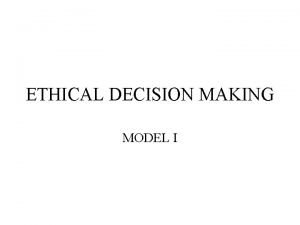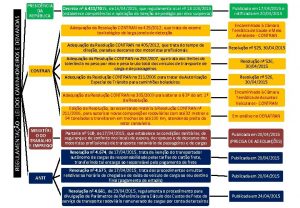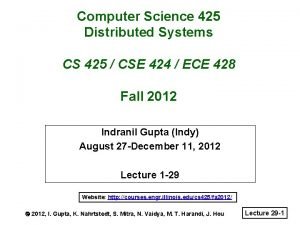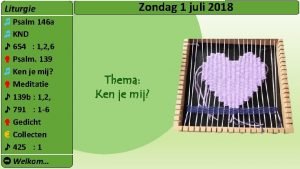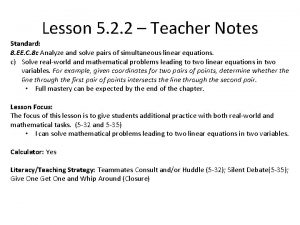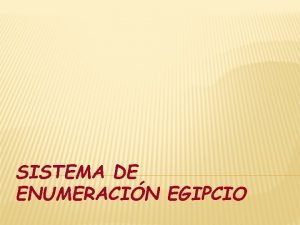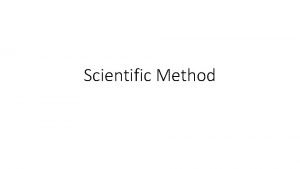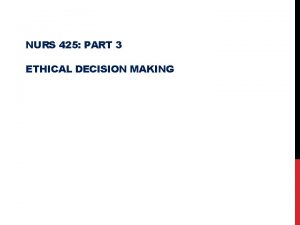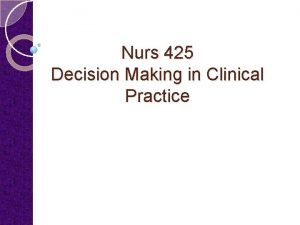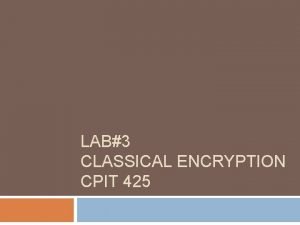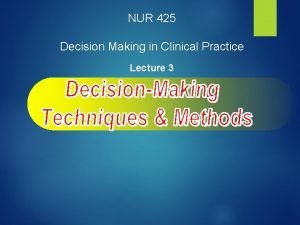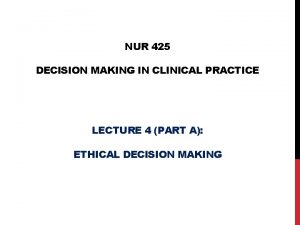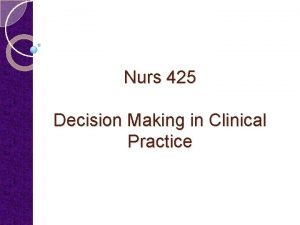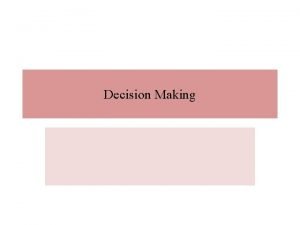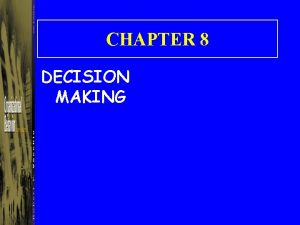NUR 425 Decision Making in Clinical Practice Introduction

























- Slides: 25

NUR 425 Decision Making in Clinical Practice Introduction to Transcultural Nursing Lecture 5

Basic Concepts w Transcultural Nursing—the study of the lifeways and patterns of persons of various cultures including their healthcare practices and nursing’s role in that culture. w International Nursing— the exchange of nurses between 2 or more nations/cultures.

Concepts (Cont’d) w Culture—the patterns and lifeways that guide a group of people’s worldview and decisionmaking. w Cultural Imposition—a situation where one culture forces their values and beliefs on another culture or subculture.

Basic Concepts w Diversity – Diverter in Latin • Being different or having differences – Diversity in nursing practice • Providing competent care to clients from different cultures, conducting research in multi-cultural settings, and implementing educational programs to diverse population 4

Concepts (Cont’d) w Acculturation—the process of adapting or modifying the patterns and lifeways of an adopted culture as a result of contact with another group or individual. w Assimilation—the process of accepting some of the cultural practices or traits of the prevailing culture into one’s own daily activities.

Concepts (cont’d) w Values—something regarded as desirable, worthy, or right, as a belief, standard, or moral precept. w Beliefs—a tenet or body of tenets; doctrine; creed.

Cultural Competence in Nursing w Demonstrating knowledge and understanding of the client’s culture. w Accepting and respecting cultural differences. w Adapting care to be congruent with the client’s culture.

4 Levels of Cultural Competence w Unconscious incompetence—not being aware that one is lacking knowledge about another culture. w Conscious incompetence—being aware that one is lacking knowledge about another culture. w Conscious competence—learning about the client’s culture, verifying generalizations about the client’s culture, and providing culturally specific interventions. w Unconscious competence—automatically providing culturally congruent care to clients of a diverse culture.


Nursing Theorists in Transcultural Nursing w Madeleine Leininger—the founder of Transcultural Nursing. Dr. Leininger studied anthropology in the 1950’s and early 60’s. She earned her Ph. D in Cultural Anthropology. She then decided that nursing was constantly dealing with the lifeways and patterns of peoples of many backgrounds and that in caring for these persons, nurses needed to be sensitive to the unique needs of all peoples. She felt strongly that we should not impose our views on others whenever possible.

Contributions of Madeleine Leininger (July 13, 1925 -August 10, 2012) to the Development of Transcultural Nursing from the TCNS website: www. tcns. org Date Contribution 1954 Leininger noticed and studied the cultural differences in the perception of care 1965 Leininger earned a doctorate in cultural anthropology [Univ. of Washington] 19651969 Leininger offered first courses and telelectures offered in Transcultural Nursing [Univ. of Colorado School of Nsg] Est. 1 st Ph. D nurse-scientist program combining anthropology and nursing[Univ. of Colorado School of Nsg] 1973 !st Academic Dept. in Transcultural Nursing est’d [Univ. of Washington, School of Nsg] 1974 Transcultural Nursing Society(TNS) est’d as the official organization of transcultural nursing. 1978 First advanced degree programs [Master’s & Doctoral] est’d [Univ. of Utah School of Nursing]

1988 Transcultural Nursing Society(TNS)—initiated certification examinations: Certified Transcultural Nurse 1989 Journal of Transcultural Nursing (JTN)— 1 st published as official publication of the TNS; Leininger is founding editor. The goal of the JTN is to disseminate transcultural ideas, theories, research findings, and/or practice experiences. 1991 Dr. Leininger published Culture Care Diversity and Universality: A theory of Nursing in which she outlines her theory [Culture Care Diversity and Universality and the Sunrise Model] and its research implications. 1995 Dr. Leininger published Transcultural Nursing— Concepts, Theories, Research & Practices as a text for undergraduate and graduate nursing students. 2001+ Dr. Leininger continued to teach a graduate level Transcultural Course at the Univ. of Northern Colorado. She guest lectured internationally at age 77!!

How to Provide Culturally Congruent Care: w Leininger suggests 3 approaches to plan and implement Culturally Congruent Care. w The first is Cultural Care Preservation/ Maintenance where we look at what we as nurses can do to preserve and maintain the cultural practices of an individual or family while receiving safe, holistic care somewhere in the Healthcare Delivery System.

How to Provide Culturally Congruent Care: (cont’d) w The second approach is Cultural Care Accommodation/Negotiation where we look at what we as nurses can do to accommodate the patient and negotiate with the patient within the healthcare environment in order to provide culturally congruent care while he/she is in the Healthcare Delivery System.

How to Provide Culturally Congruent Care: (Cont’d) w The third approach is Cultural Care Repatterning/Restructuring where we look at what we as nurses need to do with the patient and family to repattern or restructure their lifeways in order to promote healing and wellness, always being cognizant of the cultural influences that affect why they do what they do in their life experience.

HEALTH PRACTICES IN DIFFERENT CULTURES w Use of Protective Objects – Protective objects can be worn or carried or hung in the home- charms worn on a string or chain around the neck, wrist, or waist to protect the wearer from the evil eye or evil spirits.

HEALTH PRACTICES IN DIFFERENT CULTURES w Use of Substances – It is believed that certain food substances can be ingested to prevent illness. – E. g. eating raw garlic or onion to prevent illness or wear them on the body or hang them in the home. w Religious Practices -Burning of candles, rituals of redemption etc. .

HEALTH PRACTICES IN DIFFERENT CULTURES w Traditional Remedies -The use of folk or traditional medicine is seen among people from all walks of life and cultural ethnic background. w Healers -Within a given community, specific people are known to have the power to heal.

HEALTH PRACTICES IN DIFFERENT CULTURES w Gender Roles – In many cultures, the male is dominant figure and often they take decisions related to health practices and treatment. In some other cultures females are dominant. – In some cultures, women are discriminated in providing proper treatment for illness.

HEALTH PRACTICES IN DIFFERENT CULTURES w Personal Space – Respect the client's personal space when performing nursing procedures. – The nurse should also welcome visiting members of the family and extended family.

ROLE OF NURSE w Determine the client's cultural heritage and language skills. w Determine if any of his health beliefs relate to the cause of the illness or to the problem. w Collect information that any home remedies the person is taking to treat the symptoms

ROLE OF NURSE w Nurses should evaluate their attitudes toward ethnic nursing care. – Understand the influence of culture, race ðnicity on the development of social emotional relationship, child rearing practices & attitude toward health.

ROLE OF NURSE w Collect information about the socioeconomic status of the family and its influence on their health promotion and wellness w Identify the religious practices of the family and their influence on health promotion belief in families. w Understanding of the general characteristics of the major ethnic groups, but always individualize care.

ROLE OF NURSE w The nursing diagnosis for clients should include potential problems in their interaction with the health care system and problems involving the effects of culture. w The planning and implementation of nursing interventions should be adapted as much as possible to the client's cultural background.

ROLE OF NURSE w Evaluation should include the nurse's selfevaluation of attitudes and emotions toward providing nursing care to clients from diverse sociocultural backgrounds. – Self-evaluation by the nurse is crucial as he or she increases skills for interaction.
 No decision snap decision responsible decision
No decision snap decision responsible decision Financial decision
Financial decision Introduction to ethical decision making
Introduction to ethical decision making Iliad clinical decision support system
Iliad clinical decision support system Isabel clinical decision support
Isabel clinical decision support Resolução 425 do contran
Resolução 425 do contran Area code 425
Area code 425 Uiuc ece 428
Uiuc ece 428 Distributed systems course
Distributed systems course Dalam bom kalorimeter x gram karbon
Dalam bom kalorimeter x gram karbon Singel 425
Singel 425 Psalm 425
Psalm 425 Nancy started the year with $425 in the bank
Nancy started the year with $425 in the bank Aoi22 stick diagram
Aoi22 stick diagram Netff
Netff Opwekking 714
Opwekking 714 Sistema egipcio
Sistema egipcio 425 g = _____kg
425 g = _____kg Nurs 425
Nurs 425 Nurs 425
Nurs 425 Ece 425
Ece 425 Ece 425
Ece 425 Seorang pedagang membeli 1 kodi mainan seharga
Seorang pedagang membeli 1 kodi mainan seharga Seorang pedagang membeli 3 kodi pakaian dengan harga
Seorang pedagang membeli 3 kodi pakaian dengan harga Stat 425
Stat 425 425 mod 26
425 mod 26


